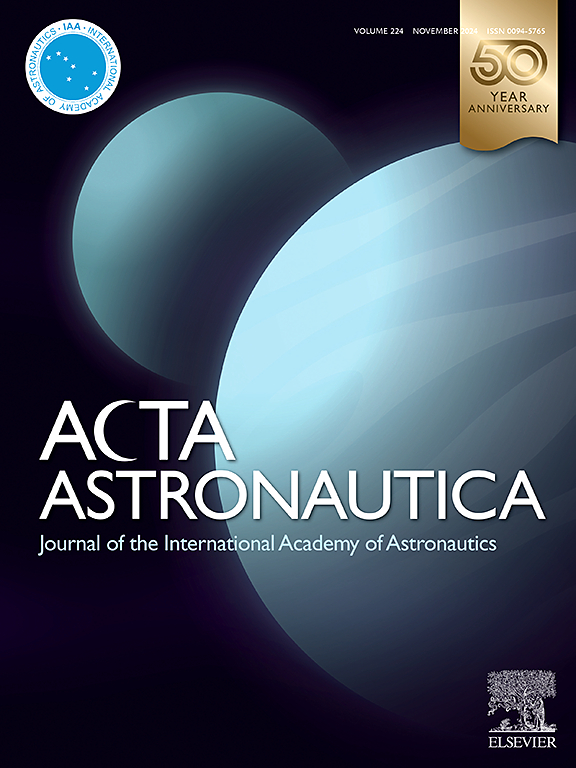行波加速提高无极洛伦兹力推力器效率的磁流体动力学模拟
IF 3.4
2区 物理与天体物理
Q1 ENGINEERING, AEROSPACE
引用次数: 0
摘要
无极洛伦兹力(ELF)推进器是一种新型的电力推进概念,它利用旋转磁场(RMF)驱动的场反转配置(FRC)等离子体产生脉冲推力,旨在实现大功率应用。针对实验中观测到的能量损失大、效率低的问题,本研究采用二维Hall磁流体力学(MHD)模型对极低频推进器中FRC等离子体的加速动力学进行了数值分析,并评估了行波加速方法的有效性。通过与推力器试验数据的直接对比,验证了模型的正确性。对力分布的分析表明,下游的轴向洛伦兹力有所下降。为了克服这一问题,提出并评估了通过偏置场调制的行波加速,加强偏置场线圈形成磁强度梯度波来进一步加速等离子体。根据实验参数,该方法在不修改RMF参数的情况下,只需增加30%的输入功率,即可实现排气速度和总动量增加50%。等离子体效率增加了一倍以上,由于等离子体残留时间缩短,能量损失减少,这表明行波加速作为一种提高极低频推进器性能的节能策略是有效的。羽流模拟表明,发散效率超过90%,这归因于冻结的磁力线,有利于窄角度排气。本文章由计算机程序翻译,如有差异,请以英文原文为准。
Magnetohydrodynamics simulation on the efficiency enhancement of electrodeless Lorentz force thrusters through traveling-wave acceleration
The electrodeless Lorentz force (ELF) Thruster is a novel electric propulsion concept that utilizes a Rotating Magnetic Field (RMF) driven Field Reversed Configuration (FRC) plasmoid to produce pulsed thrust, aimed at high-power applications. To address the substantial energy loss and low efficiency observed in the experiments, this study employed a two-dimensional Hall Magnetohydrodynamics (MHD) model to numerically analyze the acceleration dynamics of FRC plasmoids in an ELF thruster and assess the effectiveness of the traveling-wave acceleration method. The model is validated through direct comparison with the thruster test data. Analysis of the force distribution reveals a decline in the axial Lorentz force downstream. To overcome this, traveling-wave acceleration through bias field modulation is proposed and evaluated, strengthening the bias field coil to form a wave of magnetic strength gradient to accelerate the plasmoid further. Based on experimental parameters, this method achieves a 50 % increase in exhaust velocity and total momentum with only a 30 % increase in input power, without modifying the RMF parameters. The plasma efficiency more than doubles, and energy loss is reduced due to shortened plasmoid residual time, demonstrating the effectiveness of traveling-wave acceleration as a power-efficient strategy for enhancing ELF thruster performance. Plume simulations indicate over 90 % divergence efficiency, attributed to the frozen-in magnetic field lines that facilitate narrow-angle exhaust.
求助全文
通过发布文献求助,成功后即可免费获取论文全文。
去求助
来源期刊

Acta Astronautica
工程技术-工程:宇航
CiteScore
7.20
自引率
22.90%
发文量
599
审稿时长
53 days
期刊介绍:
Acta Astronautica is sponsored by the International Academy of Astronautics. Content is based on original contributions in all fields of basic, engineering, life and social space sciences and of space technology related to:
The peaceful scientific exploration of space,
Its exploitation for human welfare and progress,
Conception, design, development and operation of space-borne and Earth-based systems,
In addition to regular issues, the journal publishes selected proceedings of the annual International Astronautical Congress (IAC), transactions of the IAA and special issues on topics of current interest, such as microgravity, space station technology, geostationary orbits, and space economics. Other subject areas include satellite technology, space transportation and communications, space energy, power and propulsion, astrodynamics, extraterrestrial intelligence and Earth observations.
 求助内容:
求助内容: 应助结果提醒方式:
应助结果提醒方式:


